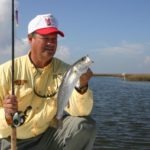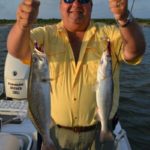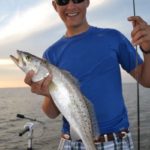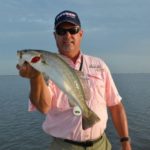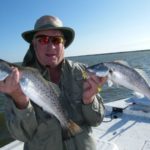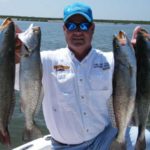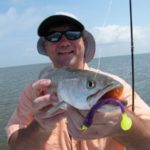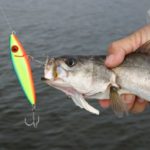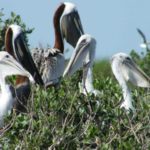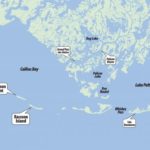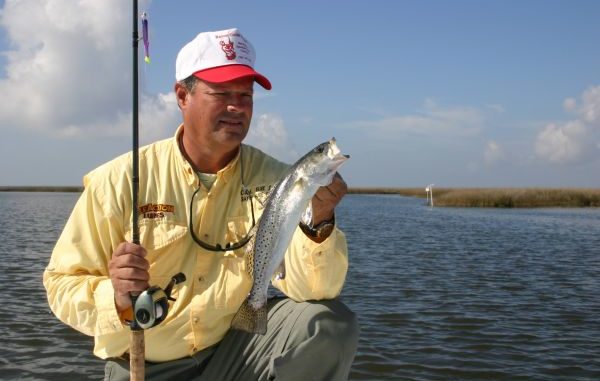
Raccoon Island’s front-side beach gets hammered by anglers looking for big trout, but the beach on the north side of the spit of sand holds lots of fish without the parade of boats.
Fishing the islands means different things to Louisiana speckled trout connoisseurs. Masses of pulverized shell, thick spartina grass rimmed by hidden oyster reefs and even near-perfect circles of roseau cane all have their place in different areas along the coast for anglers to hoist healthy yellowmouths over the gunnels.
To many lower Terrebonne Parish devotees, however, islands in late spring and summer can only mean the mostly thinning spits of hard sand and mangroves bordering bay and open Gulf.
And that means fishing the beach — by boat or waist deep — in the warm and (hopefully) salty surf, massaged by (hopefully) gently rolling swells.
In more ways than one, there’s another side to the story when examining Raccoon Island, the western-most island of the Isles Denieres chain, according to Capt. Bill Lake of Bayou Guide Service.
Lake’s a fan of the beach and its maze of ever-changing subsurface incongruities, as well as the massive man-made rock jetties that often concentrate fish as well as they’ve increased the island’s acreage.
But he’s every bit as into the backside of Raccoon Island as the front — especially when word gets out and boats of all shapes and sizes seize the front beach just outside the breakers.
“I’ve been taking people back there for many, many years when the front side of the island is too rough or there are just too many boats, but it can be excellent even when (the front beaches aren’t overwhelmed),” Lake said. “The very best time to fish one particular section is when it’s dead calm.”
Lake is speaking of the extreme western end of Raccoon Island. The inside of Raccoon Point, is a drop-off carved by strong current swinging through the intersection of the Gulf of Mexico and Caillou Bay. And there are few places he’d rather be on mornings when the weather allows him to go most anywhere.
“When I pull up and see those rafts of mullets, I just know that 90 percent of the time it’s going to be on,” he said. “You can also see shrimp moving through there, skipping along the surface.
“We all know what that means.”
Lake described his approach thusly: Pull up in line — but not too close to — the sunken shrimp boat just to the west of the point and ease your way down on the trolling motor to the end a few hundred yards to the trench, fishing as you go around the schools of bait.
“When the sun is up a little bit, you can clearly see the drop-off if the water is pretty,” Lake said. “But it’s best to be there at sunup.
“It’s an early bite, and, really, the whole island is that way. This is not a place where you can come back to at 10 a.m. and expect to do well.”
Moving toward the east is the backsides of the island flanking the huge washout that effectively cuts the island in two. The dynamics here are much less dramatic than those of Raccoon Point, with no sheer drop-off and much less current.
Lake prefers the eastern side, but indicated that wade fishermen have taken to the western side and its acres of shallow water and hard-packed sand enough that he figures there must be a good reason for them to keep going back.
“There’s no trough, no drop off, just a shallow flat that eases up into the real shallow water of the washout itself,” said Lake. “The bait doesn’t stack up like it does on the east side, but that’s what they like.”
Directions for fishing the washout are simple.
“You want to start out about 200 or 300 yards off of the cut and about 30 or 40 yards off of the bank and work your way toward it.
“When you start kicking up sand with your trolling motor as you get closer to the cut, you’ve probably missed the fish or they’re not there.”
Lake indicated that frequently shrimp can be seen working through the cut and farther to the north, with birds diving on them. But he generally gives them just a quick, polite look if anything — knowing through years of experience that the bigger fish are closer to the land and hanging around the schools of finned foodstuff.
The massive schools of bait — including mullet, pogies and bay anchovies (the small, thin and almost see-through minnows) — and the relative safety from the south wind is what drives the fish here.
“It’s all about the food and the protection back there,” Lake said. “The other day, just about every fish were spitting up those long, skinny minnows. Other days it’s those tiny pogies with the black dot flickering on the surface. The water’s almost always a pretty green back there.”
“This year, there have been big schools of mullet in there, and porpoises — gangs of 15 to 20 of them — have been tearing them up early in the morning.”
The guide added that, while there’s little question the porpoises gorge on trout, as well, generally they are on the move and don’t mess up the fishing too severely.
“They leave behind those real big, elongated slicks,” he said. “But the trout are in there, too, and their slicks have been popping up, as well.”
Differentiating between the two is easy enough, Lake said: Trout slicks are rounder and max out at about the size of a car.
Targeting those slicks been key in finding the fish in the area, though with a curious twist.
“We even had a brisk north wind the other day, and the slicks were popping up all over the place. But for some reason the fish have been wanting Carolina-rigged minnows in those spots,” Lake said. “We run the trolling motor, fishing along until we see (a slick), put the Power-Pole down and just hammer those nice, big 18- to 21-inch fish, one after another.
“But those fish have more times than not wanted minnows, for whatever reason.”
Moving toward the eastern end of the island, Lake explained another unique experience germane mainly to Raccoon Island and one borne of the Macondo oil spill.
“For six months, I took out scientists to islands all along this island chain, and they counted pelicans nesting,” Lake said. “We’d anchor at different spots, and I’d fish pretty much out of boredom.
“You couldn’t move around — you were stuck in that spot until they were ready to move, but there were plenty of times I’d catch a limit in one spot while they were counting.”
The eastern end is thick with mangroves and, of course serves as one of the biggest brown pelican rookeries in the state. The innumerable bushes also make it the most protected area on the island, providing clean, green water on even the stiffest prevailing south and southeast winds.
Looking at a map, one can see several points jutting northward. The fish generally hang on the downcurrent side, awaiting the bait that washes across the choke points.
“They’ve eroded a little bit over time, but you can still see them. We set up in about 3 feet of water and throw toward the bushes on the points,” Lake said. “It’s a place where you’re going to lose a few baits from the old, eroded roots, but we’ve thrown double-rigged baits 5 feet from the bushes and immediately doubled up.”
Lake theorized that the interruption of current — farther west is pretty much a straight shot — provided by the land and perhaps more importantly the several yards of mangrove stubble in various states of decay is what draws and holds the fish.
“We don’t fish too many topwater baits on charters, but I’ve had trout smash them literally right under the pelican nests,” said Lake. “There was a guy last year that only fished that area and only fished a red/white Top Dog.
“He caught a 7-pounder last year that I weighed on my scale.”
So next time you just can’t stomach wedging your way into the boat parade on the beach side of Raccoon Island, consider the northern side. You too might find that the water is indeed greener on the other side.
Capt. Bill Lake of Bayou Guide Service can be reached at 985-581-6015 (home) or 985-637-3712 (cell).
